#Adolph Caesar
Text

A Soldier's Story (1984). An African-American officer investigates a murder in a racially charged situation in World War II.
While it'll never quite stack up when it comes to the In the Heat of the Night comparisons (the two films share a director and thematic throughline after all), this is still an excellent, intelligent thriller grounded in great performances and a sharp script. Denzel Washington's the clear standout (I can't believe this is only his second feature!), but he's bolstered by a great cast all around. Just a really great watch. 8/10.
#a soldier's story#1984#Oscars 57#Nom: Best Picture#Nom: Supporting Actor#Nom: Adapted Screenplay#Norman Jewison#charles fuller#howard e rollins jr#adolph caesar#denzel washington#art evans#David Alan Grier#1940s#america#american#race#crime#8/10
76 notes
·
View notes
Text
'The Color Purple' Movie and 4K Review
The following review was written by Ultimate Rabbit correspondent, Tony Farinella.
This was my first time having the pleasure of sitting down to watch “The Color Purple,” directed by the legendary Steven Spielberg. This is a director who has never been afraid to tackle any type of film project. When watching this film, his trademark heart is clearly on display. What makes it stand out and be…

View On WordPress
#1980&039;s Movies#1985 Movies#4K#4K UHD#4K Ultra HD#Abuse#Adolph Caesar#African American Movies#Akosua Busia#Alice Walker#Amblin Entertainment#Ben Guillory#Book To Film#Carl Anderson#Celie#Dana Ivey#Danny Glover#Frank Marshall#Georgia#Grand Bush#HDR#Howard Starr#James Tillis#John Patton Jr.#Kathleen Kennedy#Laurence Fishburne#Leonard Jackson#Margaret Avery#Menno Meyjes#Nettie
2 notes
·
View notes
Photo

#the color purple#whoopi goldberg#danny glover#adolph caesar#margaret avery#rae dawn chong#movie poster#steven spielberg#movie posters
15 notes
·
View notes
Video
youtube
#film trailer#supercut#Adolph Caesar#voice actor#narration#blaxploitation#1970's#exploit cinema#exploitation
2 notes
·
View notes
Text


Silverhawks - Syndication - September 8, 1986 - December 5, 1986
Animated (65 episodes)
Running Time: 23 minutes
Character Voices
Commander Stargazer (voiced by Bob McFadden)
Quicksilver / Captain Jonathan Quick (voiced by Peter Newman)
Bluegrass (voiced by Larry Kenney)
Steelheart/Sergeant Emily Hart and Steelwill/Sergeant Will Hart (voiced by Maggie Jakobson Wheeler and Bob McFadden)
The Copper Kidd (vocal effects provided by Pete Cannarozzi)
Hotwing (voiced by Adolph Caesar in earlier episodes, Doug Preis in later episodes)
Flashback (voiced by Peter Newman)
Moon Stryker (voiced by Larry Kenney)
Condor (voiced by Bob McFadden)
Mon*Star (voiced by Earl Hammond)
Yes-Man (voiced by Bob McFadden)
Hardware (voiced by Bob McFadden)
Melodia (voiced by Maggie Wheeler)
Windhammer (voiced by Doug Preis)
Mo-Lec-U-Lar (voiced by Doug Preis)
Buzz-Saw (voiced by Bob McFadden)
Poker-Face (voiced by Larry Kenney)
Mumbo-Jumbo (voiced by Peter Newman)
Timestopper (voiced by Larry Kenney)
Zero the Memory Thief (voiced by Peter Newman)
Darkbird (portrayed by Peter Newman)
#Silverhawks#TV#Animated#Syndication#1986#1980's#Robert McFadden#Earl Hammond#Larry Kenney#Peter Newman#Maggie Wheeler#Doug Preis#Adolph Caesar
1 note
·
View note
Text

he brilliant Adolph Caesar (December 5, 1933 - March 6, 1986) was born in Harlem 90 years ago today. He's best known by film fans for his Oscar-nominated performance as Sergeant Waters in A SOLDIER'S STORY and as Old Mister Johnson in THE COLOR PURPLE
Yale Film Archive
0 notes
Text
Die Farbe Lila (1985)

Celies Leben ist nie sehr einfach gewesen. Sie ist nicht einmal vierzehn als ihr Vater sie missbraucht und schwängert. Beide dadurch entstandenen Kinder verkauft er, Celie bleibt die dürftige Haushaltssklavin. Der einzige Lichtblick in ihrem Leben ist ihre geliebte Schwester Nettie - die beiden Schwestern stärken sich auf ihrem Leidensweg den Rücken und halten in jeder noch so schweren Situation zusammen.
Celie wird gegen ihren Willen verheiratet und muss sich nun alleine um die drei verzogenen Kinder ihres Ehemannes und seinen Hof kümmern. Da ihr Ehemann eigentlich Nettie heiraten will, ihm dies jedoch nicht gelingt, hegt er einen Groll gegen seine Schwägerin. Im Zuge dessen verbietet er den Schwestern jeglichen Kontakt.
Celie ist nun völlig alleine den Schikanen ihres Mannes ausgesetzt, bis er auch noch eine Bluessängerin bei sich aufnimmt, mit der er eine Affäre eingegangen hat, die er seiner Frau offen verkündet. Ihm ist jedoch nicht bewusst, dass seine Ehefrau und seine Geliebte ein enges freundschaftliches Verhältnis eingehen würden.
(10/10)
#Die Farbe Lila#the color purple#Alice Walker#Whoopi Goldberg#Adolph Caesar#Danny Glover#Oprah Winfrey#Steven Spielberg#LGBTQ#Literatur#Roman#Buchverfilmung#1985
1 note
·
View note
Text
The Dionysos gallery (1)
I wanted to conclude my long series of Dionysos posts with a collection of Dionysos and Bacchus paintings that were carefully collected by the website of the French Museum of Wine! (Only in France can you have a museum of wine be a normal thing)
First we have an entire section about Dionysos himself. The page is here if you are interested.
I/ Dionysos as a child and a teenager

Giulio Romano's The Birth of Bacchus

Laurence de la Hyre's Mercury entrusting Bacchus to the Nymphs

Giovanni Bellini's Child Bacchus
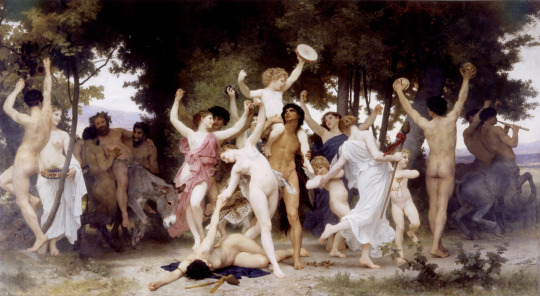
William-Adolphe Bouguereau's The Youth of Bacchus

Caravagio's Bacchus

Caesar van Everdingen's Nymphs offering wine, fruits and flowers to the young Bacchus
II) Bacchus as a god

Titien's Bacchus and Ariadne

Guido Reni's Bacchus and Ariadne

Brothers Le Nain's Bacchus discovering Ariadne at Naxos

Alessandro Turchi's Bacchus and Ariadne

Caesar van Everdingen's Bacchus with two nymphs and Cupid

Charles de la Fosse's Bacchus and Ariadne

Jean-François de Troy's Bacchus and Ariadne

Sebastiano Ricci's Bacchus and Ariadne

Jacopo Amigoni's Bacchus and Ariadne

Bartolomeo Manfredi's Bacchus and a drinker
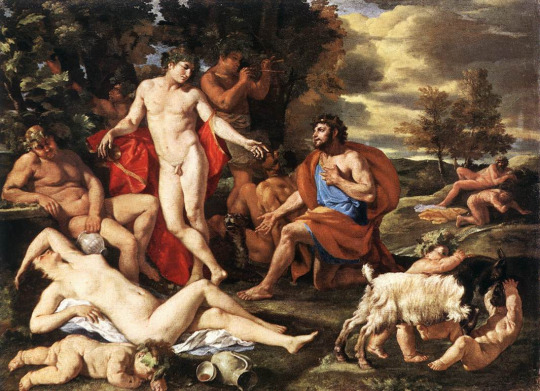
Nicolas Poussin's Midas and Bacchus
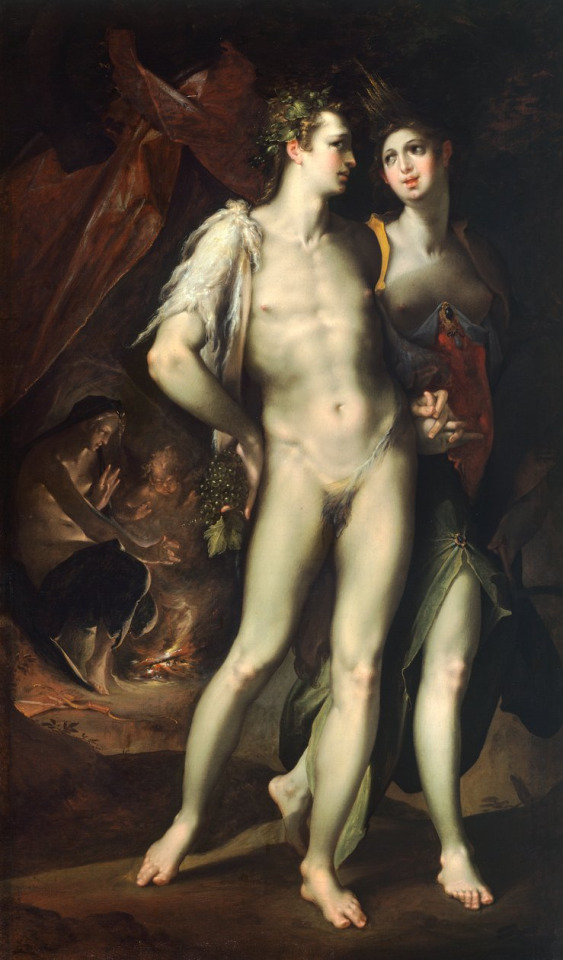
Bartholomaus Spranger's "Sine cerere et baccho friget venus", also known as Bacchus and Ceres

Louis de Caullery's Venus, Bacchus and Ceres dancing with mortals in a garden of love

Hans von Aachen's Bacchus, Ceres and Cupid

Bon Boullogne's Venus, Bacchus and Ceres

Sebastiano Ricci's Bacchus and Ceres

Maurice Dennis' Bacchus and Ariadne
#the art of the myth#dionysos#dionysus#greek god#greek mythology#ariadne#demeter#paintings#painting#art#museum#ceres#bacchus
66 notes
·
View notes
Text
Tik Tok - Ides of March Edition (A Julius Caesar (the play) fanvid and song parody)
youtube
A music video for the upcoming Ides of March!
Based on the song Tik Tok by Kesha with new lyrics and vocals by me. Audio editing by my partner.
(I know it's not the ides yet, but people play Christmas music for a month leading up to Christmas, so.)
Lyrics and artworks in the video under the cut (artist birth and death years where I could not find the year of creation).
Lyrics:
Wake up in the morning feeling hyped up from battle
No I haven't got a crown, but it ain't worth the hassle
Before I leave hear a warning from the cheering mass
I don't care, he's just a dreamer, so I leave him and pass
I'm talkin: just took out my foe, foe,
Got parades wherever I go, go
Bout time I got that throne, throne. [gasp I mean--]
On to the Senate on the Ides, Ides,
Hear the pleading of my wife, wife,
That's when it gets a little bit tricky…
[Chorus:]
Can't stop; you know the gods already made this story up
Three times, I've declined, and it's nearly the Ides
Tick Tock, on the clock, but the Senate don't stop, no
Whoa-oh oh oh, Whoa-oh oh oh
[Repeat Chorus]
Ain't got a care in the world, 'cause her dream's just a dream
And the omens that she's seen could be 'bout anything
Now the Senate's lining up, 'cause they heard I got swagger
Beggin' mercy for Publius--Wait. Is that a dagger?!
I'm talkin bout--errybody got a knife, knife
Even Brutus wants my life, life
Should'a listened to my wife, wife.
Now, now does Caesar lie so low, low,
But the people will still know, know
Of the fortune he brought Rome, Rome…
Fortune he brought
[Chorus x2]
Romans, We stabbed him but, you have to know
This was for Rome, not for power
I loved him but he had to go, a threat he posed to our freedom
Brutus, you stabbed me but, you'll see me soon
upon your doom at Philippi
You'll see me soon upon your doom, upon your doom
But the party don't start 'til Marc walks in.
[Chorus x2]
Artworks:
Brutus and Caesar's Ghost:
Brutus and the Ghost of Julius Caesar, Edwin Austin Abbey (1852–1911)
Brutus Disturbed By The Ghost Of Caesar, From Shakespeare's Julius Caesar, Act IV, Scene III, Henry Tresham (c.1751 – 17 June 1814)
Caesar's Death:
"Julius Caesar, Act III, Scene 2, the Murder Scene", George Clint (1822)
Death of Caesar, March 15, 44 BC Painting by Vincenzo Camuccini (1798)
The Assassination of Julius Caesar, William Holmes Sullivan (1888)
The Murder of Caesar, Karl von Piloty (1865)
The Death of Julius Caesar, George Esten Cooke (1837)
The Death of Caesar, by Jean-Léon Gérôme, 1867
Assassination of Julius Caesar, Spanish School, (19th century)
The Assassination of Caesar, Heinrich Füger, 1818
The death of Caesar, Victor Honoré Janssens (1658-1736)
Woodcut manuscript, Johannes Zainer, c. 1474
Marc Antony:
Marc Antony Reading the Will of Caesar, William Hilton (1786-1839)
Marc Antony's Oration, William Holmes Sullivan (1836-1908)
Declining the throne:
Caesar refuses the Diadem, 1894
Antoine offre le diademe a cesar, 1810 Copper engraving
Roman Senate:
Cicero Denounces Catiline (1888), Cesare Maccari
Caesar going to the Senate on the Ides of March, Abel de Pujol (1785-1861)
The Roman Forum by Hodgkin (1800-1860)
Soothsayer:
Beware the Ides of March Soothsayer warning Julius Caesar of the Ides of March, 1858 Wood engraving
Caesar and the Soothsayer, Illustrator Unknown, Published 1880.
Caesar's Wife pleads with him:
Cowards die many deaths - Hans Holbein the Younger (1497-1543)
Calpurnia, Caesar's wife admonishing Caesar, Abel de Pujol (1785-1861)
Triumphs of Caesar:
Julius Caesar, Andrea Mantegna, c. 1490
The Vase Bearers, Andrea Mantegna, c. 1490
Picture Bearers, Andrea Mantegna, c. 1490
Musicians, Andrea Mantegna, c. 1490
Corselet, Andrea Mantegna, c. 1490
A Roman Triumph, Rubens, c. 1630
Vercingetorix Throws Down his Arms at the Feet of Julius Caesar, Lionel Royer (1899)
Caesar Crossing the Rubicon, Adolphe Yvon, 1876
#shakespeare#kesha#ides of march#julius caesar#julius caesar (the shakespeare play)#parody#song parody#Youtube
34 notes
·
View notes
Text





















New Year’s Eve
New Year’s Eve takes place on the last day of the Gregorian calendar. The first New Year’s Eve festivities date back approximately 4,000 years, to the time of ancient Babylon; Babylonians celebrated the new year during the first new moon after the vernal equinox, in late March. During antiquity, the first days of the new year were celebrated at different times around the world, and the day was usually tied to an agricultural or astronomical event. For example, Egyptians celebrated their new year as the Nile flooded, and the Chinese New Year has long begun with the second new moon after the winter solstice.
In 46 BCE, Julius Caesar consulted with prominent astronomers and mathematicians, and introduced the Julian calendar, which closely resembles the Gregorian calendar. He made January 1 the first day of the year, partly to honor Janus, the Roman god of beginnings. At the time, the new year was celebrated by offering sacrifices to Janus, decorating homes with laurel branches, the attendance of parties, and the exchanging of gifts. During the Middle Ages, Christian leaders in Europe changed the date of New Year’s celebrations to coincide with religious holidays such as Christmas and the Feast of Annunciation. In 1582, New Year’s was reestablished to follow the Gregorian calendar by Pope Gregory XIII.
In modern times, New Year’s Eve is celebrated in various ways around the world. Many people in Spain and Spanish speaking countries eat a dozen grapes right before midnight, to symbolize their hopes for the following months. Ring shaped cakes and pastries are eaten in some countries, which signify that the year has come full circle. Legumes are eaten in various countries, which symbolize coins, and a hope for financial success in the upcoming year; lentils are popular in Italy, and black eyed peas are a favorite in the southern United States. Other popular festivities that cross international boundaries include the watching of fireworks and the singing of songs.
New Year’s Eve is not a federal holiday in the United States, but it is recognized by some states. Some organizations and stores are closed, offer limited services, or close early; schools are almost always closed. New Year’s Eve events in the United States began to gain prominence in the early 20th century. Many Americans celebrate the day and evening with parties at home and by attending public events at various places and entertainment venues. Often celebrations go long past midnight, into New Year’s Day.
The most prominent public celebration in the United States is the “ball drop” in Times Square in New York City, which has been held each year since 1907, except for a few years during World War II. Celebrations first took place in Times Square in 1904, sans a ball drop. Following the banning of fireworks in 1907, after hot ashes had fallen into the streets, Adolph Ochs, a publisher for the New York Times, wanted to replace them with something. The Times Square ball was inspired by time balls, which signaled to sailors on the seas; sailors set their chronometers after observing time balls with a spyglass. The first time balls were installed in Portsmouth, England, in 1829, and the first in the United States was installed in Washington, D.C., in 1845. The inaugural Times Square ball was made of wood and iron, and was made up of one hundred 25-watt light bulbs. As of 2017, the Times Square ball weighs 11,875 pounds, is twelve feet in diameter, is made up of 2,688 Waterford Crystal triangles, and has 32,256 LED lights. It takes the ball sixty seconds to drop down a seventy foot poll to the top of the roof on One Times Square, where it lands as midnight strikes. Similar events are held in towns and cities around the country. The surrounding geography, culture, and history inspires what is dropped as the new year begins—animals, fruit, vegetables, automobiles, and industrial machinery have all been used. Atlanta has a “peach drop” as Georgia is the peach state; Brasstown, North Carolina, lowers a live possum in a glass enclosure; and Port Clinton, Ohio, drops a six hundred pound walleye.
In 1928, Guy Lombardo and his band, The Royal Canadians, began playing an annual New Year’s Eve event at New York’s Waldorf-Astoria Hotel. Up until 1956 the event was broadcasted on the radio, and from 1956 until 1976 it was broadcasted on television, along with coverage of the ball drop. Lombardo’s group were most known for their playing of “Auld Lang Syne,” which they helped turn into the standard song of New Year’s Eve. “Auld Lang Syne” was a Scottish poem put to paper by Robert Burns in 1788. The melody is from an even older Scottish folk song. The literal translation of the song is “old long times,” meaning something close to “once upon a time.” The song first became used at British and Scottish funerals, farewells, and group celebrations, before Lombardo began playing it in the United States.
“New Year’s Rockin’ Eve” debuted on NBC in 1973, moved to ABC in 1975, and was hosted by Dick Clark for over thirty years. It was Clark’s intention that it would be a younger alternative to Lombardo’s big band music. Central Park’s Midnight Run is another New York City tradition, where fireworks are shot off, and a race around the park begins at midnight. Some other larger cities that now hold large public New Year’s Eve celebrations include Las Vegas, Los Angeles, and Chicago. Major theme parks such as Disney World and Disneyland also hold celebrations.
In the Catholic Church, January 1 is a day honoring the Virgin Mary, where a mass is attended. A vigil Mass is often held the night before on New Year’s Eve. Many other Christian churches have “Watch Night” services, which are services that go past midnight. Attendees give thanks for the blessings of the previous year, and pray for blessings in the year ahead. These services trace their roots back to John Wesley, the founder of Methodism.
New Year’s Eve is being observed today! It has always been observed annually on December 31st.
There are many ways you could celebrate the day and evening. Gather with family or friends at a home, find a public event, or go to an establishment that is having a New Year’s Eve party, where there may be music, dancing, drinks, and food. If you are celebrating at someone’s house, you could bring along a snack or a bottle of Champagne. Watch the ball drop and other coverage of the new year on television, or ring in the new year by setting off your own fireworks and singing “Auld Lang Syne.” If you are feeling more contemplative you could write new year’s resolutions, detailing things you hope to accomplish in the following year, or you could attend a church service or Mass.
Source
#New Year’s Eve#NYE#31 December#fireworks#Domaine Carneros#sparkling wine#don't drink and drive#Napa Valley#USA#Navy Pier Fireworks#Chicago#original photography#summer 2019#Mumm Napa#Champagne#Lake Michigan#California#Illinois#Schweiz#Switzerland#NewYearsEve#happy new year#travel#vacation#tourist attraction
5 notes
·
View notes
Note
Hey!
Please tell me more about the mirrors! :D
I'm tagging @vcaudley in this since Ria also wanted to know ^.^ (Thank you both so much for feeding into my shenanigans)
The story of Kronos is a pretty easy one, right? Kronos the titan, god of time, who deposed and castrated his own father. [Interesting and relevant tidbit: Kronos may have been the god of time specifically viewed as a destructive, all-devouring force.] Anyway, Cronus, fearing the prophesy foretelling that he'd be deposed by his own son, devours all of his children with the titaness Rhea, goddess of motherhood and generations. But Rhea gives birth to her youngest son Zeus in secret, tricking Kronos with a swaddled rock, and Zeus grows up to depose his father and free his siblings.
What I'm proposing, and bear with me here, is that the story of Kronos can be a cyclical one. Kronos devours his son [ie destroys whatever made his son different from himself] and when he becomes a father himself, the son perpetuates the cycle and devours his own son. It's a role forced upon each generation. The more you fight it, the more painful your devouring becomes, so why fight it at all?
There's a quote from the play Elektra by Sophocles:

I always think of it when I am working on the Montrose family and their dynamics.
Laurent Montrose, current family head and rotten old bastard, is Kronos. He clings to power, despite his age, and does so with an iron fist and a cruel smile. He knows what makes the perfect Montrose leader, the perfect crime boss, and that is himself. He won't allow his descendants to be any less.
Caesar Montrose, son of Laurent, is another Kronos, molded and guided by his father. He knows his duty; that he must devour his son, to make him the perfect leader. It does not matter that he has not one, but four children. He will devour them all.
Xiaoli Yuen-Montrose, wife of Caesar, is Rhea. This one caught me a bit by surprise, because Xiaoli is every bit as mercenary and cold as her counterparts. But she is a mirror for Rhea. She watches Caesar devour two of their children, and decides that her youngest will be spared. And perhaps, by being spared, they will end this cycle of father devouring son.
Lucas Montrose, the eldest child of Caesar, is set to be another Kronos. He takes after Laurent, cruel and proud - and thanks to two generatons of Kronos before him, sees no other path for himself. His Rhea did not save him.
Adrien Montrose, youngest child of Caesar, is Zeus. The cycle breaker. Shielded by Rhea from Kronos' all-devouring force. Not completely, he still learned hatred and ruthlessness at his father's feet, but enough. Enough to give him strength to step out of the cycle, to say 'no more'. Strength to fight back against the three generations of Kronos trying to devour him.
Anyway, I realized that I have three different paintings of 'Saturn/Kronos Devouring his Son' by de Goya, Muttoni, and Rubens in my 'Montrose' folder, as well as 'Sacrifice of Isaac' by Caravaggio, 'Dante and Virgil' by William-Adolphe Bouguereau, and 'The Struggle for Existence' by George Bouverie Goddard and they make me feel some kind of way towards this fucked-up family
I haven't decided what the eventual trajectory of Adrien's deposement of his grandfather/father/brother will be, but I have plans >:3
6 notes
·
View notes
Text
To celebrate the Ides of March, here are my two favorite paintings of JC:
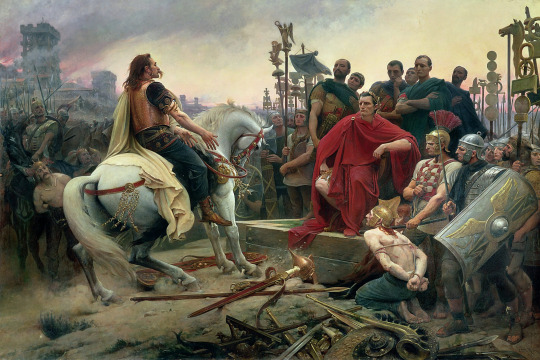
For his “goddamn he’s so cool and majestic” side, Vercingetorix Throws Down his Arms at the Feet of Julius Caesar, Lionel Royer, 1899

For his “he did kill and enslave an enormous amount of people, tho” side, Caesar Crossing the Rubicon, Adolphe Yvon, 1875
13 notes
·
View notes
Text
Events 3.18 (before 1930)
37 – Roman Senate annuls Tiberius' will and proclaims Gaius Julius Caesar Augustus Germanicus (aka Caligula = Little Boots) emperor.
1068 – An earthquake in the Levant and the Arabian Peninsula leaves up to 20,000 dead.
1229 – Frederick II, Holy Roman Emperor, declares himself King of Jerusalem in the Sixth Crusade.
1241 – First Mongol invasion of Poland: Mongols overwhelm Polish armies in Kraków in the Battle of Chmielnik and plunder the city.
1314 – Jacques de Molay, the 23rd and final Grand Master of the Knights Templar, is burned at the stake.
1438 – Albert II of Habsburg becomes King of the Romans.
1571 – Valletta is made the capital city of Malta.
1608 – Susenyos is formally crowned Emperor of Ethiopia.
1644 – The Third Anglo-Powhatan War begins in the Colony of Virginia.
1673 – English lord John Berkeley sold his half of New Jersey to the Quakers
1741 – New York governor George Clarke's complex at Fort George is burned in an arson attack, starting the New York Conspiracy of 1741.
1766 – American Revolution: The British Parliament repeals the Stamp Act.
1793 – The first modern republic in Germany, the Republic of Mainz, is declared by Andreas Joseph Hofmann.
1793 – Flanders Campaign of the French Revolution, Battle of Neerwinden.
1834 – Six farm labourers from Tolpuddle, Dorset, England are sentenced to be transported to Australia for forming a trade union.
1848 – The premiere of Fry's Leonora in Philadelphia is the first known performance of an grand opera by an American composer.
1848 – Revolutions of 1848: A rebellion arose in Milan which in five days of street fighting drove Marshal Radetzky and his Austrian soldiers from the city.
1865 – American Civil War: The Congress of the Confederate States adjourns for the last time.
1871 – Declaration of the Paris Commune; President of the French Republic, Adolphe Thiers, orders the evacuation of Paris.
1874 – The Hawaiian Kingdom signs a treaty with the United States granting exclusive trade rights.
1899 – Phoebe, a satellite of Saturn, becomes the first to be discovered with photographs, taken in August 1898, by William Henry Pickering.
1901 – The Kumasi Mutiny of 1901 begins.
1902 – Macario Sakay issues Presidential Order No. 1 of his Tagalog Republic.
1913 – King George I of Greece is assassinated in the recently liberated city of Thessaloniki.
1915 – World War I: During the Battle of Gallipoli, three battleships are sunk during a failed British and French naval attack on the Dardanelles.
1921 – The second Peace of Riga is signed between Poland and the Soviet Union.
1921 – The Kronstadt rebellion is suppressed by the Red Army.
1921 – Mongolian Revolution of 1921: The Mongolian People's Army defeated local Chinese forces at Altanbulag, Selenge (then known as Maimachen). This battle was seen as the birthday of the People's Army and completed the expulsion of Chinese militants in Mongolia.
1922 – In India, Mohandas Gandhi is sentenced to six years in prison for civil disobedience, of which he serves only two.
1925 – The Tri-State Tornado hits the Midwestern states of Missouri, Illinois, and Indiana, killing 695 people.
1 note
·
View note
Text

"The Hitter" (1979) is a late-entry blaxploitation film that features "Superfly" star Ron O'Neal and his love interest from the movie Shelia Frazier. After the success of "Superfly," Ron O'Neal was much more successful in Hollywood, starring in over 50 films and directing two movies. "The Hitter" is a tough movie as we journey with O'Neal and his street-fighting hustle. It's an enjoyable movie as the film's leading trio of actors, O'Neal, Frazier, and Adolph Caesar, carry you through with their cool and charismatic personalities. Caesar saw his first significant role in this movie and did not disappoint.
Like many blaxploitation movies, the soundtrack (produced by Garfeel Ruff) makes the film slightly better than it is. Still, it's a personal favorite film of mine, and I recommend it to those who want to get that nostalgic feeling of the era.
Director: Christopher Leitch
Writers: Christopher Leitch (screenplay), Ben Harris (screenplay)
Starring Ron O'Neal, Sheila Frazier, Adolph Caesar, Bill Cobbs, Dorothi Fox, Alfie Brown
Storyline
An ex-professional boxer (O'Neal) tries to make a new start when teaming up with a fast-talking but aging hoodlum (Ceaser) and an ex-call girl (Frazier) but soon get more than they bargained for when crossing an adversary from their past (Cobbs).
This movie is only available on VHS, YouTube, and other streaming services. I would like to see a remastered release one day soon
2 notes
·
View notes
Text

Politician, tactician, orator and an ambitious man. Gaius Julius Caesar is without doubt the most famous man of Roman history and needs no introductions.
Born in the year 100 BC, Caesar was a member of the patrician family gens Julia, who according to legends descended from Aeneas´ son Julus (Ascanius). About Aeneas, who claimed to be the son of Venus/Aphrodite we briefly talked about in our previous post, feel free to check it out! While the family was ancient, at that time it had no great political influence.
Alongside Gnaeus Pompeius Magnus and Marcus Licinius Crassus they represented the First Triumvirate, which was a political alliance whose purpose was to keep the three in power. Caesar´s tactical prowess was most famously shown in the Gallic Wars and the Civil war.
Caesar laid the foundations for the Roman Republic to turn into an Empire, but he himself never became an Emperor. He was assassinated on the 15th of March, also known as Ides of March.
In Gladiator Chronicles we see him depicted in the various beautiful backgrounds in the form of statues and art. Makes us wonder how history went in this world…



Statue of Julius Caesar, Via dei Fori Imperiali, Rome; Statue in the background of GC Caesar palace and a hologram in Flavius´ ludus
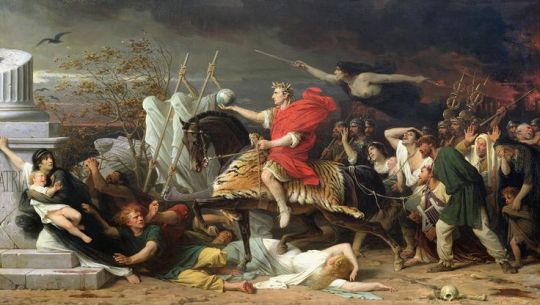

Caesar crossing the Rubicon by Adolphe Yvon; 1875; Painting in the background of Labelle´s office
#romance club#gladiator chronicles#gc appreciation week#rcgcaw#rc appreciation weeks#rc gladiator chronicles#lore
26 notes
·
View notes
